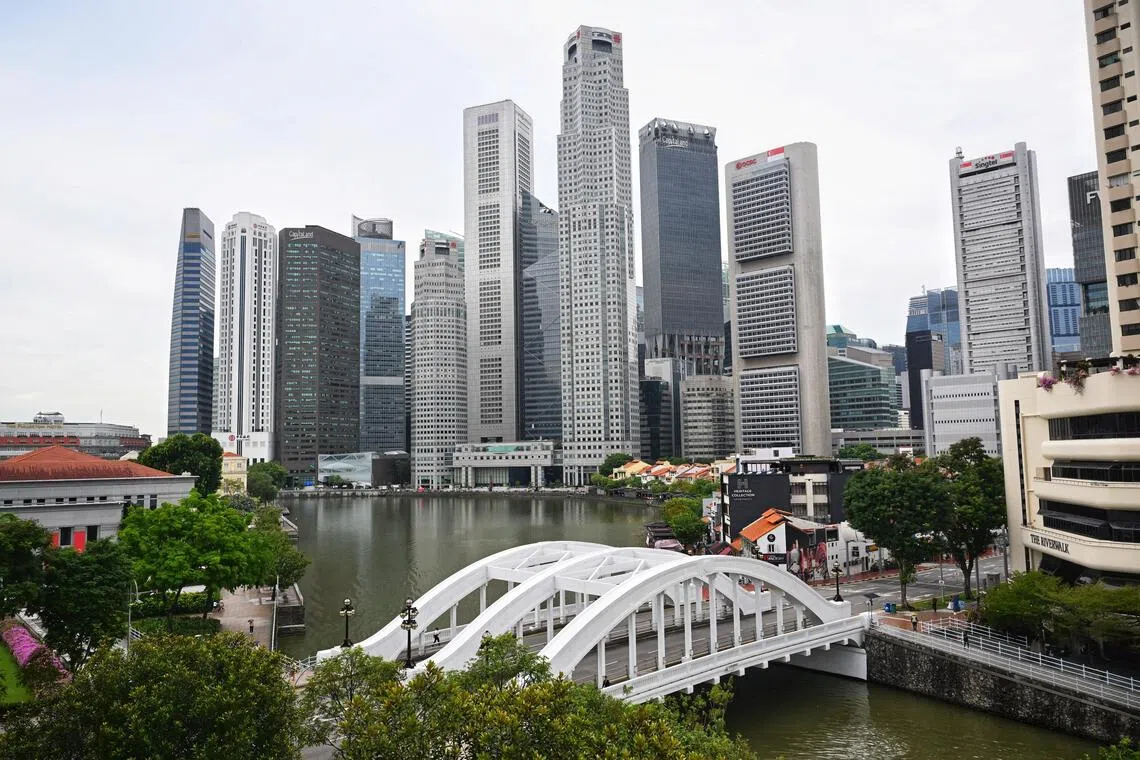Singapore banks can weather severe shocks with strong capital buffers: MAS
Sign up now: Get ST's newsletters delivered to your inbox

In its assessment of Singapore’s banking sector, MAS said the overall banking vulnerability level remains benign.
PHOTO: ST FILE
Follow topic:
- Singapore's banks possess strong capital buffers, exceeding Basel III requirements, enabling them to withstand severe economic shocks, according to MAS stress tests.
- Singapore's non-bank financial institutions (NBFIs) have grown, with insurance companies well-capitalised, but face risks from global economic uncertainty.
- MAS notes emerging global credit stress, particularly in auto loans and corporate credit, with concerns about banks' links to less transparent NBFIs.
AI generated
SINGAPORE - Banks in Singapore have adequate capital buffers to withstand severe shocks, the Monetary Authority of Singapore (MAS) said.
Its industrywide stress test of domestic systemically important banks (D-SIBs) showed these banks are well positioned to weather potential shocks even in adverse situations such as a deep global recession and protracted severe financial stresses, thanks to strong capital buffers.
The three local banks – DBS Bank, OCBC Bank and UOB – as well as Citibank, Maybank, Standard Chartered and HSBC, are on the list of D-SIBs that face additional supervisory measures.
Locally incorporated D-SIBs need to meet higher capital requirements than those for ordinary banks – a minimum Common Equity Tier 1 capital adequacy ratio (CAR) of 6.5 per cent, a Tier 1 CAR of 8 per cent and a Total CAR of 10 per cent.
These are also more stringent than the Basel III requirements. Basel III is an international regulatory framework for banks that sets minimum standards on capital adequacy, liquidity and leverage to make the global banking system more resilient.
Each of these banks maintains sound credit risk management practices with adequate provisioning buffers to absorb potential credit losses, MAS said in its annual financial stability review on Nov 5.
In its assessment of Singapore’s banking sector, MAS said the overall banking vulnerability level remains benign.

PHOTO: MAS
Liquidity and maturity risks have stayed low in 2025, with banks maintaining healthy liquidity positions and stable loan-to-deposit ratios.
Leverage vulnerabilities for both residents and non-residents are low amid strong capital buffers. Credit to non-bank entities expanded at a healthy pace over the past year, supported by strong growth in loans to resident borrowers.
Resident credit growth has been underpinned by lending to the trade-related sectors, which were in turn buoyed by front-loading of exports ahead of the new tariffs by the US and strong global demand for electronics linked to artificial intelligence-related products.
Asset quality has remained generally strong, with non-performing loan (NPL) ratios falling across most sectors. A lower NPL ratio signifies a healthier loan portfolio, with lower risk of default.
However, the transport and storage sector, and the accommodation and food services sector saw upticks in their NPL ratios. The food services sector in particular was weighed down by cost pressures and demand shortfalls.
Turning to domestic non-bank financial institutions (NBFIs), which include insurance firms and other financial intermediaries, MAS said assets in this sector have grown 9.7 per cent over the past year, driven by investment funds and trust companies as global equity and credit markets delivered strong returns.
The insurance industry in Singapore remains well capitalised, with the average CARs for direct life and general insurers well above regulatory requirements.
The direct life insurance sector saw an increase in new business premiums for the first half of 2025 compared with a year earlier, driven by sales of investment-linked policies.
The direct general insurance sector also reported solid gross premium growth for the first half of 2025, driven by business in Singapore, coupled with favourable underwriting results and investment income.
Direct life and composite insurers reported sustained growth in their invested assets, with a slight shift in allocation towards equity securities in recent quarters.
Credit quality of debt securities held by insurers and reinsurers was good, with over 90 per cent of these securities classified as investment grade. Most of the unrated debt securities were those issued by Singapore statutory boards and Temasek-linked companies, MAS said.
It said the linkages between crypto-asset players and the broader financial system are limited, and there has been minimal spillover from volatility in the cryptocurrency markets into the broader system.
Stress tests of Singapore investment funds and insurers indicate that the sectors are well positioned to weather global shocks, with limited risk spillovers to the rest of the domestic financial system.
However, there are concerns about global macroeconomic uncertainty, elevated asset valuations and fiscal sustainability that present risks for NBFIs in Singapore.
“These risks may manifest as sharp repricing shocks, with the potential to cause spikes in investor redemptions or impose capital losses on insurers,” MAS said.
Globally, signs of credit stress are emerging in certain sectors, it said.
Banks in some advanced economies continue to report higher delinquency rates for their auto and credit card portfolios, along with some resurgence in student loan delinquencies.
Softer economic conditions and weaker labour markets could affect the financial resilience of more vulnerable households.
There are also concerns that the benign pricing of corporate credit risks could reverse sharply should trade-oriented corporates report lower profits or face cash-flow strains.
At the same time, banks’ growing links to NBFIs raise contagion, liquidity and credit risks.
Some global banks have reported high-profile credit losses from distressed private credit-backed borrowers, fuelling concerns about weaker credit underwriting and loan monitoring processes.
These risks are amplified by private credit firms’ lack of transparency and use of complex financing structures involving leverage, MAS said.
The commercial real estate sector also remains a key source of credit risk amid an uneven global downturn, given banks’ exposure there.


